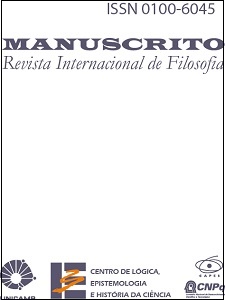Resumen
Este artigo examina o papel das intenções do falante no que diz respeito à determinação da referência para expressões, concentrando-se nos demonstrativos. Intuitivamente, o referente de um proferimento-token de ‘aquilo’ é fixado (pelo menos em parte) pelas intenções do falante. Se isto é correto, no entanto, temos um problema potencial para as chamadas teorias formais do significado. Eu começarei fixando a natureza deste problema e, em seguida, explorarei três supostas soluções. Primeiro, a assunção de que a intenção do falante fixa a referência nestes casos pode ser rejeitada; segundo, pode ser sustentada a tese de que as intenções correntes do falante são relevantes, mas podem ser acomodadas em uma teoria semântica formal; terceiro, a determinação da referência e o conteúdo semântico podem ser mantidos estritamente separados. Eu rejeito as duas primeiras possibilidades acima, chamadas respectivamente de ‘convencionalismo’ e ‘não-inferencialismo’, mas argumento que a terceira provê uma forma atraente para o semanticista formal de acomodar o conteúdo de expressões sensíveis ao contexto.
Abstract:
This paper examines the role of speaker intentions in issues of reference determination for context-sensitive expressions, focusing on demonstratives. Intuitively, the referent of a token utterance of ‘that’ is fixed (at least in part) by the speaker’s intentions. However, if this is right it causes a potential problem for so-called formal theories of meaning. I begin by setting out the nature of this problem and proceed to explore three putative solutions. First, the assumption that speaker intentions fix reference in these cases may be rejected; second, it may be held that current speaker intentions are relevant but that they can be accommodated within a formal semantic theory; third, reference determination and semantic content may be held strictly apart. I reject the first two of these moves, termed respectively ‘conventionalism’ and ‘non-inferentialism’, but argue that the third move provides an appealing way for the formal semanticist to accommodate the content of context-sensitive expressions.
Keywords: Speaker’s Intention. Reference. Context. Demonstratives. Meaning.
Citas
ARBIB, M., OZTOP, E., ZUCKOW-GOLDRING, P. “Language and the Mirror System: a perception/action based approach to communicative development”. Cognition, Brain, Behaviour, 3: 239-272, 2005.
BACH, K. “Intentions and demonstrations”. Analysis, 52:140-146, 1992a.
BACH, K. “Paving the road to reference”. Philosophical Studies, 67(3):295-300, 1992b.
BACH, K. “The semantics-pragmatics distinction: what it is and why it matters”. In The Semantics/Pragmatics Interface from Different Points of View, edited by K. Turner: Elsevier Science, 65-83, 1999.
BALDWIN, D., BAIRD, J. “Discerning intention in dynamic human action”. Trends in Cognitive Sciences, 5: 171-178, 2001.
BARON-COHEN, S. Mindblindness: An essay on autism and theory of mind. Cambridge, Mass.: MIT Press, 1995.
BLOOM, P. How Children Learn the Meanings of Words. Cambridge, Mass.: MIT Press, 2000.
BORG, E. “Formal semantics and intentional states”. Analysis, 64: 215-223, 2004.
BORG, E. Minimal Semantics. Oxford: Clarendon Press, 2004a.
BORG, E. “If mirror neurons are the answer, what was the question?”. Journal of Consciousness Studies, 14: 5-19, 2007.
BORG, E. “Minimalism versus contextualism in semantics”. In: G. Preyer and G. Peter (eds.). Context Sensitivity and Semantic Minimalism: Essays on Semantics and Pragmatics. Oxford: Oxford University Press, pp. 546-571, 2007a.
CARPENTER, M., CALL, J., TOMASELLO, M. “A new false belief test for 36-month-olds”. British Journal of Developmental Psychology, 20: 393-420, 2002.
CORAZZA, E., FISH, W., GORVETT, J. “Who is I?”. Philosophical Studies, 107: 1-21, 2002.
DAVIDSON, D. Inquiries into Truth and Interpretation. Oxford: Clarendon Press, 1984.
GALLAGHER, S. The practice of mind: theory, simulation or primary interaction?. Journal of Consciousness Studies 8: 83-108, 2001.
GALLAGHER, S. “Perceiving others in action”. Fondements cognitifs de l’interaction avec autri. Collège de France, 2006.
GALLESE, V., GOLDMAN, A. “Mirror neurons and the simulation theory of mind reading”. Trends in Cognitive Science, 2: 493-501, 1998.
GAUKER, C. “Zero tolerance for pragmatics”. Synthese, 165: 359- 371, 2008.
HIGGINBOTHAM, J. “Elucidations of Meaning”. Linguistics and Philosophy, 12: 465-517, 1989.
IACOBONI, M. et al. “Grasping the intentions of others with one’s own mirror neuron system”. PLoS Biology, 3, e79: 0001-0007, 2005.
KAPLAN, D. “Demonstratives”. In: J. Almog, J. Perry and H. Wettstein (eds.). Themes from Kaplan. Oxford: Oxford University Press, 481-564, 1977.
KAPLAN, D. “Afterthoughts”. In: J. Almog, J. Perry and H. Wettstein (eds.). Themes from Kaplan. Oxford: Oxford University Press, 565-614, 1989.
MCDOWELL, J. “On ‘the Reality of the Past’”. In: C. Hookway and P. Pettit (eds.). Action and Interpretation: Studies in the Philosophy of the Social Sciences. Cambridge: Cambridge University Press, 127-144, 1978. Reprinted in McDowell 1998, page references to there.
MCDOWELL, J. Mind and World. London: Harvard University Press, 1994.
MCDOWELL, J. Meaning, Knowledge and Reality. Harvard: Harvard University Press, 1998.
MCGINN, C. “The mechanisms of reference”. Synthese, 49: 157-186, 1981.
NEALE, S. “Heavy hands, magic, and scene-reading traps”. European Journal of Analytic Philosophy, 3: 77-132, 2007.
PREDELLI, S. “I am not here now”. Analysis, 58: 107-115, 1998.
PREDELLI, S. “Utterance, interpretation, and the logic of indexicals”. Mind and Language, 13(3):400-414, 1998.
REIMER, M. “Do demonstrations have semantic significance?” Analysis, 51: 177-183, 1991.
REIMER, M. “Three views of demonstrative reference”. Synthese, 93(3): 373-402, 1992.
RUSSELL, B. “Knowledge by acquaintance and knowledge by description”. In: Mysticism and Logic, edited by B. Russell. London: Allen and Unwin, 152-167, 1911.
WETTSTEIN, H. “Demonstrative reference and definite descriptions”. Philosophical Studies, 40: 241-57, 1981.
WETTSTEIN, H. “How to bridge the gap between meaning and reference”. Synthese, 58: 63-84, 1984.
WITTGENSTEIN, L. Philosophical Investigations. Transl. and edited by G.E.M. Anscombe. Oxford: Blackwell, 1953.

